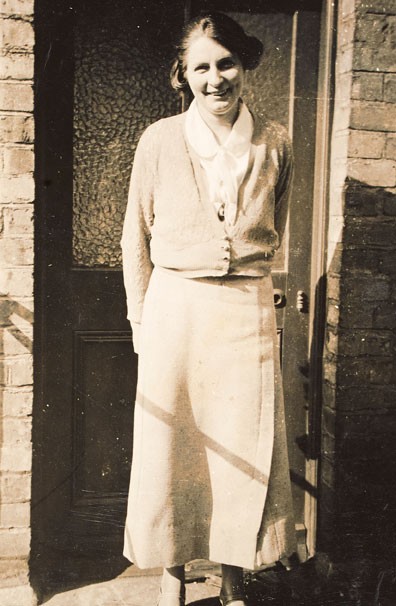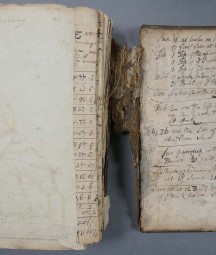by Fiona Hughes, NLI Archival Student
Annie O’Farrelly (or Áine Ní Fhaircheallaigh) is typical of many figures in Irish history and the revolutionary period. Neither a household name nor a familiar face, she was, nevertheless, immersed in Republican activity in the early twentieth century. This is demonstrable in her papers which can be accessed at the National Library here: http://catalogue.nli.ie/Collection/vtls000610501#
Born in Dublin in 1901, O’Farrelly came from a Republican background. Her grandfather Peter Boylan was a Fenian and her mother opened the family home to members of the IRA. A member of Cumann na mBan along with her sisters, O’Farrelly collected on behalf of the Irish Republican Prisoners’ Dependents Fund in the War of Independence, 1919-1921, and, during the Irish Civil War, 1922-1923, she worked in the office of the Adjutant General, IRA.

Photograph of Annie O'Farrelly (MS 47,647/1/6)
Following the outbreak of Civil War in June 1922, Annie was arrested and imprisoned in Mountjoy Prison, Kilmainham Jail and North Dublin Union with her sister, Rita. Her involvement with the Republican movement continued after release and she worked at Republican newspaper ‘An Phoblacht’ and was a member of the Cumann na mBan Executive and Clan na Gael in the 1930s.
Previously available on microfilm only, the Annie O’Farrelly Papers is a single-box, paper-based collection that includes news cuttings, letters and photographs. Dating approximately from 1915 to the 1950s, the collection largely relates to O’Farrelly’s involvement with Cumann na mBan and the IRA.
One of the collection’s most remarkable features is a unique series of letters by O’Farrelly to family members while she was imprisoned during the Civil War. This personal correspondence brims with enquiry about family, friends and the ‘outside world’ and is permeated with humour and defiance. Written from a female prisoner’s perspective, the letters counter-balance male voices, such as Peadar O’Donnell and Ernie O’Malley, that have formed the dominant Civil War narrative.
O’Farrelly’s letters convey the tumult of prison life. She refers to the refusal by the Catholic clergy to grant women prisoners absolution, to escape attempts and discovery of tunnels, to hunger strikes, to the stoppage of parcels and to the dire conditions in prison. According to Annie, ‘B’ wing in Kilmainham Gaol was “a dreadful part of the prison which has been condemned”. Indeed, the harsh reality of prison life is apparent. On 22 April 1923, she wrote simply that “Some of the men were shot in our exercise yard”.

Despite imprisonment, the good-humouredness evident in O’Farrelly’s letters would probably have consoled her mother, who was named Annie Farrelly (she did not use the ‘O’Farrelly’ adopted by her daughters). O’Farrelly wrote reassuringly that she and Rita “are both feeling splendid in spite of our splendid isolation from the outside world” and they were “taking [our] holidays as best we can”. Letters signed “Your loving child” highlight O’Farrelly’s tender age: by 1923, she was only 22 years of age.
Annie’s demands from the outside world were simple: stamps, toothpaste, tea and sugar, for example. She mentions prisoner activities, such as making clothes and various amusements, that would have tempered the ennui of prison life. “We were at a party to-night in ‘Blarney Castle’ with some of the Cork girls and had great fun”, she informed her mother.
O’Farrelly’s stalwart Republican convictions transpire through the letters. In early 1923, Annie and Rita undertook a seven-day hunger strike and, upon commencement, she wrote, “Both Rita and I are feeling very fit after it but indeed we were hungry for 7 days”. She proudly informed her mother, “The Staters have done everything they can to try and break us but no use”.
In another letter, O’Farrelly provided an in-depth account of a conflict between female prisoners and prison and military authorities in Kilmainham Gaol. Her aversion to these authority figures caused her to declare “such awful looking creatures you never saw in your life”. Indeed, Annie appears to have relished being somewhat of a burden to the fledgling Free State. “Its [sic] some satisfaction to know we are being kept at the expense of the “Free” State…288 women is costing them a good penny not to talk of 16,000 men throughout jails in Ireland”, she remarked. Letters written later in life shows her Republican beliefs were undiminished. In the 1940s, she encouraged others in what she considered was “obviously their duty if they still hold on to old Republican faith”.
When the Civil War concluded in May 1923, O’Farrelly remained a prisoner. Surviving letters in the collection confirm that her imprisonment began in at least November 1922 (an autographed letter from Mountjoy Jail Military Governor Philip Cosgrave to O’Farrelly’s mother evinces this). She was eventually released by October 1923.
Other Civil War items in the collection include a notice for missing jewellery lost during the “Big Battle”, a set of rules governing prisoner conduct at North Dublin Union and a small prison diary dated August 1922.
Civil War material aside, the collection happily boasts a substantial amount of O'Farrelly's correspondence. A plethora of recognisable names including Richard Mulcahy (one of his letters is addressed ‘Fernside’, a War of Independence Republican haunt), Ernie O’Malley, Sighle Humphreys, Peadar O’Donnell and Frank Ryan are featured and indicate the level of O’Farrelly’s Republican connection.

Letter from Ernie O'Malley (MS 47,640/41)
Letters concerning ‘An Phoblacht’ and a large number of IRA communiqués and Cumann na mBan documents dating from the 1920s and 1930s also feature. Some documents are cryptically signed with initials or amusing aliases such as “Mr. Lightside” and “Mr. Heaviside”. Indeed, touches of light-hearted humour contrast with official documentation present in the papers. An unsigned letter to O’Farrelly regarding her “celery” (salary) and containing a rhyme with words ending in “-ski” illustrates this. Personal effects in the collection also contrast with official documents; for example, an intimate letter expressing sorrow on the death of O’Farrelly’s sister Mollie in 1921.
Other personal paraphernalia in the papers adds to our picture of O’Farrelly. Minutes of meetings for Irish language group, An Grágaire, of which she was a member, as well as an Irish-German Society membership card dated 1951 - 52 are included. O’Farrelly’s Defence of the Realm Permit Book (1918) is a fascinating item situated within the wider political framework that contains Annie’s personal details as well as her photograph (always good to put a face to the name!) It is one of two photographs of O’Farrelly in the collection: the other shows her standing outside the office of ‘An Phoblacht’.
Indeed, photographs add an absorbing dimension to the collection. An abundant visual black and white feast, they document the Republican movement and commemorations in the 1930s. This includes photographs of the annual Bodenstown pilgrimage featuring Cumann na mBan, IRA and Fianna Éireann. Also featured is a profound and poignant photograph of the body of Tony D’Arcy, who died on hunger strike in 1940. These items confirm that Republican activity continued post-Civil War. Further illustrating this point are agenda for Cumann na mBan conventions in 1925 and 1927, an IRA Constitution for 1925 and two beautifully coloured cards from IRA detainees at the Curragh internment camp in 1944 that are contained in the collection.

1930's commemoration photo /Cumann na mban-graveside (MS 47,547/3/6
Biographical accounts and contemporary newspaper cuttings concerning IRA Chief of Staff Seán Russell, who died in 1940, feature heavily. A close friend of O’Farrelly, the collection contains a wedding invitation addressed to both as guests as well as a cheque signed by Russell. Also in the collection is typed evidence provided at the inquest in to the death of Harry Boland and a confession by former IRA Chief of Staff and alleged informer Stephen Hayes.
An enthralling and pertinent collection since we are in the throes of celebrating the Decade of Centenaries, the Annie O’Farrelly Papers offer a tangible glimpse into recent Irish history, with particular focus on the Republican movement. The collection demonstrates how diverse and wonderful archival material can be and the papers threw up items as varied as an IRA timesheet to a glove pattern. Furthermore, it highlights the often neglected, yet pivotal, role played by women in the Irish revolutionary period and reference made throughout the papers to various known and unknown individuals shows how the fabric of Irish history was woven by ordinary men and women as well as more celebrated figures. The Annie O’Farrelly Papers are a must-see for students of twentieth-century Ireland and are a valuable asset to the National Library of Ireland’s collections.

